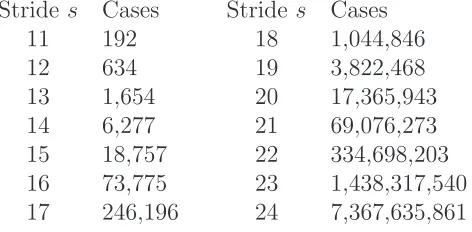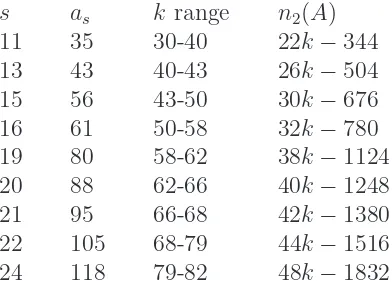23 11
Article 09.1.1
Journal of Integer Sequences, Vol. 12 (2009), 2
3 6 1 47
Some Postage Stamp 2-Bases
John P. Robinson
Coordinated Laboratory for Computational Genomics
University of Iowa
Iowa City, IA 52242
USA
[email protected]
Abstract
A set of kintegers is a 2-basis if every positive integer up toncan be expressed as
the sum of no more than 2 values from the set; an extremal 2-basis is one for which
n is as large as possible. A new algorithm extends the lower bound of Mossige for symmetric bases. An assumed modulo structure is combined with local search. These 2-bases match all known extremal values forkfrom 11 to 20. Bases out tok= 82 are
given.
1
Introduction
The global postage-stamp problem (GPSP) consists of determining, for given positive inte-gers h and k, a set of k positive integers
Ak ={1 = a1 <· · ·< ak}
such that
1. sums of h (or fewer) of these aj can realize the numbers 1,2, . . . , n,
2. the value of n is as large as possible.
This extremal total is denoted nh(k). The h-range for a particular set A is denoted
nh(A). Informally, hdenotes the maximum number of stamps on an envelope, whilek is the
number of stamp denominations.
Mossige [1] presented efficient search algorithms for determining nh(k), which Shallit [4]
has shown to be NP-hard. The extremal GPSP for k = 3 has been solved for any h and Mossige has constructed very goodh-bases fork = 4 which are believed to be extremal [2,3].
This note considers only the h = 2 case. Most of the known extremal GPSP 2-bases are symmetric, i.e., ai+ak−i = ak for i = 1, . . . , k. For some values of k there are several
extremal 2-bases solutions. Fork = 11, there are 4 solutions, two of them being symmetric. The instancek = 10 is the only known case with no symmetric extremal solution.
Mossige [1] gave extremal symmetric 2-bases for k from 15 to 30 (Table 4). To date, these out to k= 20 have been shown to be globally extremal (seeA001212 of Sloane’s table [5]). Our search algorithm uses some properties of these bases.
2
Construction
We consider only theh= 2 case and will generate symmetric 2-bases, i.e. ai+ak−i =ak for
i = 1, . . . , k. Let s denote a repeated central difference following an initial preamble, e.g., row 4 of Table 4 [1], k = 18, has the first half difference sequence 1,2,1,1,3,6,6,6,6, and we say s = 6. The complete difference sequence is k elements long with the second half the reverse of the first half.
We refer to s as the stride of the bases. The initial s elements ai we call the preamble;
the central basis elementsai corresponding to the differences ofswe call the amble. Mossige
[1] has the same 6 element preamble (1,2,1,1,3,6) for the first 7 values of k; the amble just gets longer ask increases.
From Table 4 [1] we observe the following for these globally extremal bases:
Property 1: The first s−1 elementsaj have distinct nonzero residues modulo s.
Property 2: Element as repeats a nonzero residue modulo s.
Property 3: The first s elements match any following sequence of difference values s.
Preamble construction:
1. Assume a positive integer value for s.
2. Enumerate all possible s element 2-range preambles with properties 1 and 2.
3. Report those sets with property 3 with maximum as.
It is easy to show that this construction is an algorithm. Property 1 is combined with admissibility to prune the combinations. Table 1 lists the experiential number of preamble cases that were examined. This number grows by a factor of about 4 for each increment in s. We call a resulting preamble a PAwhich has two parameters s and as.
Table 1: Number of candidate preamble cases for various stride lengths s.
Stride s Cases Stride s Cases
11 192 18 1,044,846
12 634 19 3,822,468
13 1,654 20 17,365,943 14 6,277 21 69,076,273 15 18,757 22 334,698,203 16 73,775 23 1,438,317,540 17 246,196 24 7,367,635,861
From a PA we can construct a basis fork≥2s. The PA and its reversal have 2selements; thus the length of the amble isk−2s. The largest elementak is equal to the sum of all the
differences. For a symmetric basis, n2(A) = 2ak, and
n2(A) = 2ks+ 4as−4s2 for k ≥2s.
Note that this 2-range grows as 4as. Our construction yields all known extremal GPSP
2-bases fork > 11 [5]. Representative most efficient PAs are listed in Table2.
Table 2: Most efficient PAs for s= 11, . . . ,24
s {as}
11 {1,3,4,7,8,9,16,17,21,24,35}
13 {1,2,5,7,10,11,19,21,22,25,29,30,43}
15 {1,2,5,6,8,9,13,19,22,27,29,33,40,41,56}
16 {1,2,5,8,10,12,19,22,23,25,30,31,36,43,45,61}
19 {1,2,3,6,9,11,12,15,16,27,32,37,45,48,52,55,61,62,80}
20 {1,2,4,5,11,13,14,19,29,35,37,43,46,47,50,52,56,58,68,88}
21 {1,2,3,6,10,14,17,19,26,29,36,41,49,51,54,55,58,60,67,74,95}
22 {1,3,5,7,8,12,14,18,26,32,33,42,43,50,60,63,68,79,81,83,97,105}
24 {1,2,3,5,9,12,15,17,23,28,32,35,37,44,45,66,79,82,86,91,94,102,112,118}
3
Observations
Some values ofsyield poor bases, e.g. s= 7 is bested by either s= 6 ors = 8. Other values have singular points e.g. s = 10 has 2 symmetric bases [1] which tie s = 9 and s = 11 at
k = 30. In Table 3 we report a bests fork from 30 to about 82. The corresponding PAs are in Table 2.
The bases constructed from Table 2, for the ranges in Table 3, are all above the 2k2/7 lower bound construction of Mossige [1]. Our bases suggest extremaln2(k) of about 5k2/16.
Table 3: Bestn2(A) for the symmetric bases
s as k range n2(A) 11 35 30-40 22k−344 13 43 40-43 26k−504 15 56 43-50 30k−676 16 61 50-58 32k−780 19 80 58-62 38k−1124 20 88 62-66 40k−1248 21 95 66-68 42k−1380 22 105 68-79 44k−1516 24 118 79-82 48k−1832
References
[1] S. Mossige, Algorithms for computing theh-range of the postage stamp problem, Math. Comp. 36 (1981), 575–582.
[2] S. Mossige, The postage stamp problem: the extremal basis fork = 4,J. Number Theory
90 (2001), 44–61.
[3] E. S. Selmer, On the postage stamp problem with three stamp denominations, Math. Scand. 47 (1980), 29–71.
[4] J. Shallit, The computational complexity of the local postage stamp problem, ACM SIGACT News 33 (2002), 90–94.
[5] N. J. A. Sloane,The On-Line Encylopedia of Integer Sequences, 2008.
2000 Mathematics Subject Classification: Primary 11B13.
Keywords: h-basis, extremalh-basis.
(Concerned with sequenceA001212.)
Received September 9 2008; revised version received November 19 2008. Published inJournal of Integer Sequences, December 14 2008.
Return to Journal of Integer Sequences home page.

